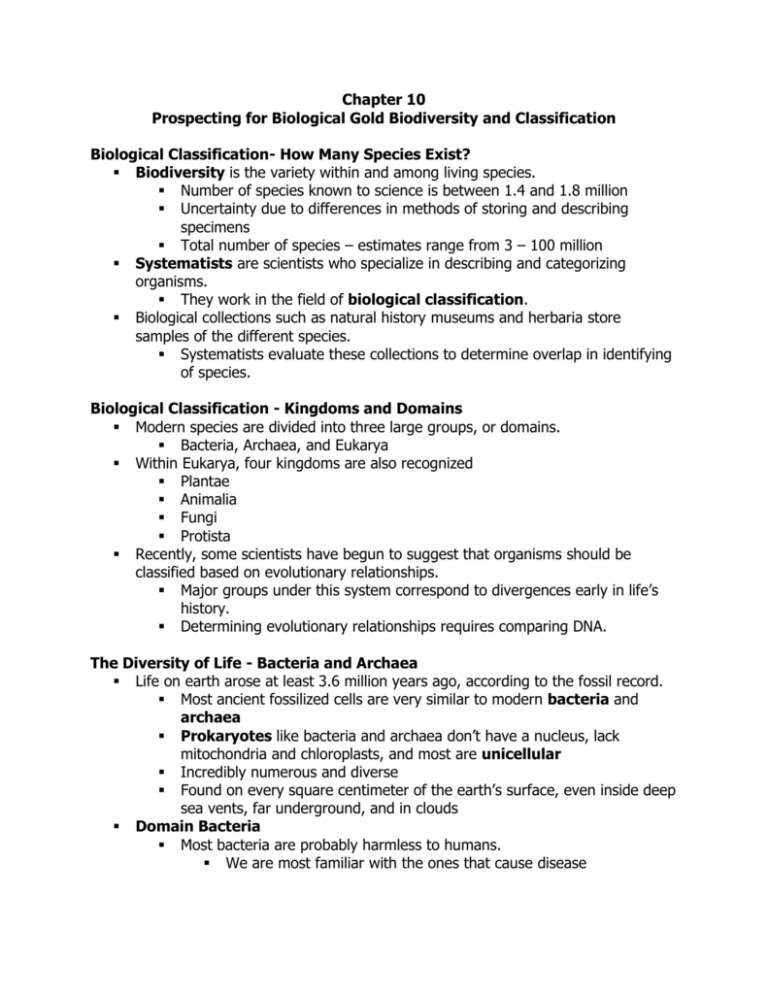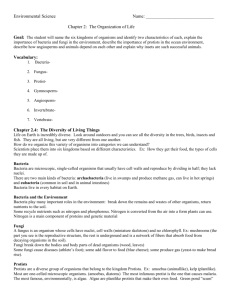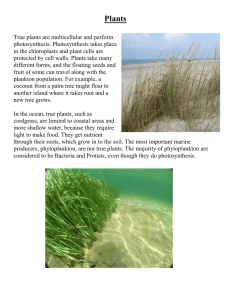Ch 10 Notes
advertisement

Chapter 10 Prospecting for Biological Gold Biodiversity and Classification Biological Classification- How Many Species Exist? Biodiversity is the variety within and among living species. Number of species known to science is between 1.4 and 1.8 million Uncertainty due to differences in methods of storing and describing specimens Total number of species – estimates range from 3 – 100 million Systematists are scientists who specialize in describing and categorizing organisms. They work in the field of biological classification. Biological collections such as natural history museums and herbaria store samples of the different species. Systematists evaluate these collections to determine overlap in identifying of species. Biological Classification - Kingdoms and Domains Modern species are divided into three large groups, or domains. Bacteria, Archaea, and Eukarya Within Eukarya, four kingdoms are also recognized Plantae Animalia Fungi Protista Recently, some scientists have begun to suggest that organisms should be classified based on evolutionary relationships. Major groups under this system correspond to divergences early in life’s history. Determining evolutionary relationships requires comparing DNA. The Diversity of Life - Bacteria and Archaea Life on earth arose at least 3.6 million years ago, according to the fossil record. Most ancient fossilized cells are very similar to modern bacteria and archaea Prokaryotes like bacteria and archaea don’t have a nucleus, lack mitochondria and chloroplasts, and most are unicellular Incredibly numerous and diverse Found on every square centimeter of the earth’s surface, even inside deep sea vents, far underground, and in clouds Domain Bacteria Most bacteria are probably harmless to humans. We are most familiar with the ones that cause disease Many known bacteria obtain nutrients by decomposing dead organisms Competition between bacteria has produced compounds that humans make use of. Antibiotics – ~50% of antibiotics are derived from bacterial sources Restriction enzymes – proteins that chop DNA at specific sequences; useful in biotechnology Domain Archaea Superficially similar to bacteria Differ in structure of cell membranes Archaeans typically found in extreme environments (high temperature, high pressure, high salt concentration) Taq polymerase comes from an archaean, Thermophilus aquaticus Archaeans are likely to be source of other interesting biomolecules The Diversity of Life – Domain Eukarya Evolution of the Eukaryotes Protists are the simplest of the eukaryotes Oldest eukaryotic fossils are ~2 billion years old, 1.5 billion years later than the first prokaryotic cells Endosymbiotic theory explains the evolution of eukaryotes and their specialized structures. The Diversity of Life – Protista Modern protists contain members that resemble animals, plants, and fungi. Most members of the kingdom are not known No agreement among scientists on number of groups below kingdom Number of proposed groups ranges from 8 to 80 Algae has the ability to manufacture food. Bioprospectors have examined the plant-like protists most closely for useful compounds. Natural selection has driven the evolution of defensive compounds in these organisms. Extracts from red algae might be used in anti-viral medication. Carageenan, a stabilizer and thickener, also comes from protists. The Diversity of Life – Animalia Animals comprise a wide range of organisms, but all share a common set of characteristics. Multicellular Heterotrophic (must eat to get energy) Mobile during at least one stage of life By 530 million years ago, all modern animal groups were present. Most appeared quickly in fossil record Multicellular organisms quickly proliferated Known as Cambrian explosion Most bioprospecting work focuses on invertebrates. Vertebrates only account for ~4% of animals Invertebrates are far more numerous and diverse Many invertebrates produce compounds found nowhere else in nature The Diversity of Life – Fungi Fungi characteristics Immobile Many reproduce by releasing spores Heterotrophic Feed by means of hyphae The hyphae of fungi can extend over a very large area DNA analysis by mycologists indicates fungi is more closely related to animals than to plants Commercially important fungal forms Yeast is a single celled type of fungi that is used in bread, wine, and beer making. Mold is quickly reproducing and fast growing to produce flavorful cheeses Fungi produce a number of important drugs Antibiotics Cyclosporin Statins The Diversity of Life – Plantae Characteristics of Plantae Multicellular Eukaryotic Autotrophic (manufacture own food) via photosynthesis Plants have been present on land for ~400 million years. First plants were low to ground, lacked vascular tissue Evolution of vascular tissue for water and nutrient transport Allowed growth to tree size Allowed growth in drier areas Most modern plants in group only ~140 million years old Flowering plants Over 90% of modern plants are flowering plants and many specializations Rapid increase of flower plant species is called adaptive radiation. Flowering plants employ double fertilization method or reproduction Also often involve animals in reproductive process (pollination) Also synthesize many secondary compounds that deter predators Kingdom Plantae is the source of many drugs and compounds. Source of most naturally derived drugs Aspirin, Digitalis, Morphine, and Caffeine Pharmaceutical manufacturers reproduce hundreds of compounds first found in plants The Diversity of Life – Viruses A virus consists of a strand of DNA or RNA. Considered non-living because they are unable to grow or reproduce without assistance from other organisms Viruses hijack transcription machinery of cells to reproduce Once hijacked cell cannot perform own functions HIV, SARS, smallpox, polio, influenza are all caused by viruses Learning About Species – Fishing For Useful Species The National Cancer Institute has employed a brute-force approach to looking for anti-cancer compounds. Receive specimens from around the world, extract materials and screen against cancer cell lines One major compound, Taxol, has been identified using this technique Learning About Species – Understanding Ecology Understanding an organism’s ecology—how it lives in its environment—can be helpful in evaluating potentially beneficial compounds. Survival in extreme environments High levels of competition with bacteria and fungi Susceptibility to predation Ability to live on or in other organisms Survival in high population densities Learning About Species – Reconstructing Evolutionary History A classification system reflecting evolutionary relationships is more useful to scientists. An organism’s chemical traits will probably be similar to those of its closest relative If looking for new compounds, could begin by screening close relatives of organisms already known to produce compounds The challenge in making an evolutionary classification is that organisms do not always resemble their closest living relatives. Reconstructing evolutionary history not always as easy as the sparrow example. Can be confounded by loss of traits, and convergence DNA provides a means of testing evolutionary hypotheses Learning About Species – Testing Evolutionary Classifications Scientists can test evolutionary hypotheses with data from fossils and from living organisms. Fossils provide information about the genealogy of different living groups Comparison of DNA from living organisms can also validate or refute proposed classifications DNA supports vulture classification, but does not support sparrow classification DNA can give clues to near relatives, but lab process can take time Learning About Species – Learning From the Shamans Often local people in biologically diverse areas make extensive use of naturally occurring products. Shamans often have much knowledge of locally useful compounds. Biopiracy is when local knowledge is used without benefiting local people. UN Convention on Biodiversity is supposed to address this. Our biodiversity represents an enormous potential, but only if we recognize its value.









